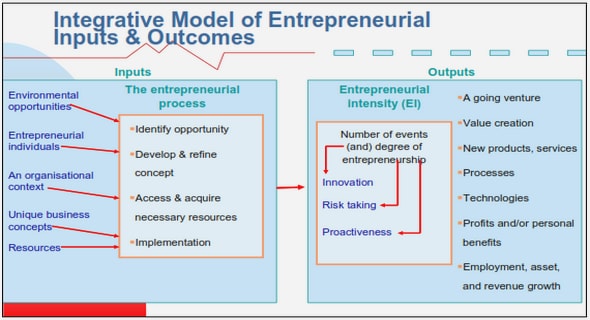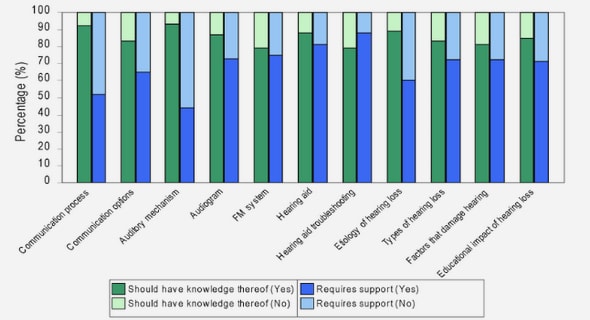Get Complete Project Material File(s) Now! »
CHAPTER 2 CONCEPTUAL FRAMEWORK
INTRODUCTION
This chapter focuses on the concepts pertaining to hearing impairment, deaf culture and the way learners and teachers perceive it. Many aspects of wellness affect learners in their classrooms. This is affected in subjects in the curriculum and extra-curricular activities. Sign language is an important communication tool for intellectual wellness of learners with hearing impairment (Storbeck, 2009). The study will emphasize the competence in communication, using sign language to communicate with other hearing-impaired learners (Bauman & Murray, 2014; Infante Matus, 2009; Kauppinnen & Jokinen, 2013). It will also establish how emotionally well learners with hearing impairment are as the system and in particular, teachers address their barriers to learning.
BACKGROUND TO DEAFNESS
The ear and deafness
The ear is made up of three parts. The outer ear is the visible part of the ear that traps sounds into the eardrum. The eardrum is located between the outer and the middle ear. The middle ear is made up of small bones, which conduct sound through into the inner ear. The inner ear has the cochlear, which is responsible for hearing. Information from the inner ear is transmitted to the brain for interpretation. Each of the three parts has a role to play in hearing (Storbeck, 2011).
Levels of hearing loss range from 26dB to 91dB+ for people who can be considered as having profound hearing loss. An audiogram is used to assess hearing and determines the degree of hearing loss in children (Storbeck, 2011). Levels of hearing loss are illustrated in Table 2.1 next page.
A person whose hearing falls in the category of 0 to 25dB is considered hearing. A person with between 26 – 40dB is considered hard of hearing and having mild hearing loss. In a quiet environment, the person can communicate effectively. However, faint and distant sounds are inaudible to the individual (Northern & Downs, 2000: 14). Such a person can benefit from wearing aids. People with moderate hearing loss have 41 – 55 dB and are also hard of hearing. Such a child can only benefit from conversation at close range. The person is likely to encounter difficulties when it comes to group work (John, 2008: 45). A person who has moderately severe hearing loss (56- 70 dB) is considered deaf. The person can only hear sound if it is loud and clear. The person is most likely to have trouble with class discussions (Benedict, Rivera & Antia, 2015). A person who has severe hearing loss (71- 90 dB) only hears loud sounds. The individual is unaware of sounds in the environment. The person needs amplification of sound to recognise them (Northern & Downs, 2000)
Deaf people and deaf culture
One cannot talk about people with hearing impairment without talking about their culture. The culture of people is their shared experiences, of knowledge, values, beliefs, customs, practices, and language (Chimedza, 2001). Culture is important for group survival and maintaining the group identity. Deaf culture is a set of beliefs and practices shared by a group of people with hearing impairment using common sign language, shared norms, values, and beliefs. People with hearing impairment derive their identity as people, who use sign language, have common interests, and prefer to marry within the group. They define deafness as an identity, not an inadequacy (Chimedza, 2001). Being in a community of people who are hearing impaired and refer to themselves as deaf identify, stay/ live, communicate, and have common values (Mcllroy, 2010).The deaf community includes other people who are not hearing impaired, family members, sign language interpreters and people who work or socialize with them. People who are hearing impaired people meet at local, national and international levels on social, athletics, scholarly, religious and literary levels. They join and become members of deaf clubs and cultural groups. Membership of the culture is having positive attitude about people with hearing impairment and identifying with the culture and being acceptable in the community (Marshark & Hauser, 2012; Sovang & Haualand, 2014)
Learning patterns of deaf learners
Learners with hearing impairment are visual learners. The appearance of the classroom needs to be attractive for them to learn effectively (Archbold & O’Donoghue, 2009; Marshark & Haer, 2012). This also calls for visual teaching methods such as the use of pictures and diagrams. The seating arrangement needs to be well thought out. The learner with hearing impairment should be seated in such a way that they see the teacher clearly as well as their peers. Where possible, this can be done in a semi-circle seating shape (Storbeck, 2009). Background noise should be avoided because it disturbs the learning of the child who is hearing impaired (Thomas, 2015). The use of DVDs is also important because they are visual and enhance the learning of the child with hearing impairment (Department of Education, 2011).
Challenges of communication
Communication between a learner who is hearing impaired and a teacher can be a major barrier to learning for some of the learners. The background noise can be heard but human speech can be difficult to understand (Marshark & Hauser, 2012). Learners who become hearing impaired after gaining speech are in a better position. They may speak sufficiently well that other people can assume that they can hear well yet they need suitable adjustments to ensure good communication (Benedict, et al., 2015).
Learners with hearing impairment may also not be immediately aware of who is speaking and miss on lip reading clues (Archbold & O’Donoghue, 2009). This is particularly true in an inclusive environment. Sustaining good communication strategies can be hard to maintain. Learners with hearing impairment frequently comment that their teachers start well but then forget them. Teachers, therefore, need to be reminded of the presence of deaf learners in their classroom if teaching is to be accessed by the deaf and hard of hearing in an inclusive classroom (Thomas, 2015). Certain strategies need to be borne in mind, including inclusive teaching, universal design for learning, sustaining learner motivation and recognising barriers to learning (Dalton, McKenzie & Kaonde, 2012; Fernandes & Myers, 2010; Solvang & Haualand, 2014).
The Deaf community culture
People with hearing impairment regard sign language as the foundation of their culture. They distinguish between users who acquire the language before six years as ‘pure signers’. The pure signers say that they can recognize the approximate age at which a person acquired sign language by the way that they use facial expressions ((Bauman & Murray, 2014). People who acquired sign language in late childhood are not regarded as pure signers. Advocates of people with hearing impairment regard cochlear implants negatively because they feel that it delays the individual to acquire sign language. They also regard children who are hearing impaired and are raised orally as having ‘cultural homelessness’ (South African Rights Commission, 2012). Some even deplore the use of cochlear implants as a form of cultural genocide because they believe such people want to kill deaf culture. Sign language is a common heritage and inability to sign can lead to exclusion from the deaf culture (Mcllroy, 2010). A person who is hearing impaired who cannot sign is not considered a member of the deaf culture. Attitudinal deafness also plays a role with persons who acquired sign language in early childhood, prejudicing against those who acquired it later. They also prejudice against anyone considered hearing because they consider oral communication negatively. They are negative about anyone outside their culture. Even hearing professionals who work in an area of hearing impairment are not spared. Some even go to the extent that hearing parents of children with hearing impairment should accept that their child who is hearing impaired is not hundred per cent theirs (DBE, 2013). Prejudice is used as a means to maintain the legitimacy of deaf culture (Bellentine, 2010). A division exists in deaf culture whereby the pure signers regard themselves as the ‘in group’ and the other members as the ‘out group’ (Mcllroy, 2010).
CHAPTER 1 OVERVIEW OF THE STUDY
1.1 INTRODUCTION
1.2 RATIONALE AND MOTIVATION
1.3 PROBLEM STATEMENT
1.4 RESEARCH QUESTIONS
1.5 RESEARCH AIMS AND OBJECTIVES
1.6 SIGNIFICANCE OF THE STUDY
1.7 CONTRIBUTION TO THE BODY OF KNOWLEDGE
1.8 THEORETICAL FRAMEWORK
1.9 RESEARCH DESIGN AND METHODOLOGY
1.10 METHODS OF DATA VERIFICATION
1.11 ETHICS
1.12 CLARIFICATION OF CONCEPTS
1.13 DEMARCATION OF THE STUDY
CHAPTER 2 CONCEPTUAL FRAMEWORK
2.1 INTRODUCTION
2.2 BACKGROUND TO DEAFNESS
2.3 IDENTIFYING BARRIERS TO LEARNING
2.4 SUMMARY
CHAPTER 3 THEORETICAL FRAMEWORK
3.1 INTRODUCTION
3.2 UNIVERSAL DESIGN FOR LEARNING AND EDUCATION OF DEAF LEARNERS
3.3 LINGUISTIC INTERDEPENDENCE THEORY AND EDUCATION OF DEAF LEARNERS
3.4 THE WELLNESS THEORY
3.5 HOLISTIC APPROACHES TO WELLNESS
3.6 WELLNESS MODELS
3.7 SUMMARY
CHAPTER 4 DESIGN AND METHODOLOGY
4.1 INTRODUCTION
4.2 RESEARCH PARADIGM
4.3 RESEARCH DESIGN
4.4 POPULATION AND SAMPLE
4.5 INSTRUMENTS
4.6 DATA COLLECTION PROCEDURES
4.7 CONCURRENT DATA ANALYSIS DESIGN
4.8 ISSUES OF QUALITY IN RESEARCH
4.9 TRUSTWORTHINESS
4.10 ETHICS
4.11 SUMMARY
CHAPTER 5 QUANTITATIVE RESULTS
5.1 INTRODUCTION
5.2 QUANTITATIVE ANALYSIS
5.3 DESCRIPTIVE STATISTICS AND NORMALITY TESTS OF VARIABLES
5.4 INDEPENDENT T TESTS SHOWING DIFFERENCES OF MEANS BY TWO GROUPS
5.5 INDEPENDENT T TEST TO SHOW DIFFERENCES BY GENDER
5.6 ANALYSIS OF VARIANCE SHOWING SIGNIFICANT DIFFERENCES BETWEEN SOCIO-DEMOGRAPHIC VARIABLES OF TWO GROUPS
5.7 ANOVA TEST TO DETERMINE DIFFERENCES IN MEANS BY AGE
5.8 ANOVA TEST TO DETERMINE DIFFERENCES IN MEANS BY HOME LANGUAGE
5.9 ANOVA TEST TO DETERMINE DIFFERENCES IN MEANS BY HIGHEST PROFESSIONAL QUALIFICATION
5.10 ANOVA TEST TO DETERMINE DIFFERENCES IN MEANS BY TEACHING EXPERIENCE
5.11 ANOVA TEST TO DETERMINE DIFFERENCES IN MEANS BY TEACHING DEAF LEARNERS
5.12 SUMMARY
CHAPTER 6 QUALITATIVE DATA ANALYSIS
6.1 INTRODUCTION
6.2 DATA ANALYSIS PROCEDURES
6.3 CATEGORIES DEVELOPED FROM CODING
6.4 THEMES FROM QUALITATIVE DATA
6.5 SUMMARY
CHAPTER 7 DISCUSSION OF THE FINDINGS
7.1 INTRODUCTION
7.2 DISCUSSION OF FINDINGS
7.3 SUMMARY
CHAPTER 8 OVERVIEW OF THE STUDY, MODEL DEVELOPMENT, CONCLUSIONS AND RECOMMENDATIONS
8.1 INTRODUCTION
8.2 OVERVIEW OF THE STUDY
8.3 INTEGRATED WELLNESS MODEL IN ADDRESSING BARRIERS TO LEARNING
8.4 IMPLEMENTING THE INTEGRATED WELLNESS MODEL
8.5 STRENGTH OF THE STUDY
8.6 CONTRIBUTION OF THE STUDY
8.7 LIMITATION OF THE STUDY
8.8 CONCLUSIONS
8.6 RECOMMENDATIONS
8.7 RECOMMENDATIONS FOR FUTURE RESEARCH
REFERENCES
GET THE COMPLETE PROJECT


